
Rust forms when iron meets oxygen and moisture. Prevent it by cleaning and thoroughly drying tools after use, storing them undercover or in protective covers, oiling/coating metal parts, sharpening and choosing rust-resistant metals, and inspecting regularly. Remove existing rust with sanding, steel wool, power tools, or vinegar.
How to Protect Your Garden Tools from Rust This Winter
Most garden tools have metal components. Depending on the type of tools and machinery concerned, this might just encompass their blades or extend to other areas, such as the housing. Either way, if you’re going to effectively maintain your gardening equipment this winter, you need to know how to protect its metal parts from rust.
Here, we explain exactly what causes rust, how it differs from corrosion, and the problems resulting from it. We then discuss the best ways to prevent rust, before wrapping things up with a look at how to get rust off garden tools, should it appear.
So, if you want to know how to stop garden tools from rusting, please read on…
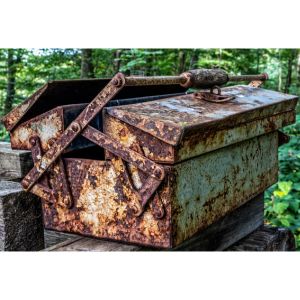 What Causes Rust?
What Causes Rust?
Rust is iron oxide, which forms as a reaction between iron and oxygen in the presence of water or moisture. It is reddish brown in colour and can appear on the surface of iron or its alloys, for example steel, if that metal is exposed to a combination of air and moisture.
Rust vs Corrosion
Many people use the words ‘rust’ and ‘corrosion’ interchangeably, but corrosion is a much broader term. It can occur on a range of surfaces, but usually refers to the conversion of a metal into an oxide, hydroxide, or sulphide. Corrosion can be composed of different elements’ salts, and is caused by exposure to air, moisture or various chemicals.
As rust is solely concerned with iron and its alloys, it can be viewed as a type of corrosion, rather than being exactly the same thing.
Problems Caused by Rust
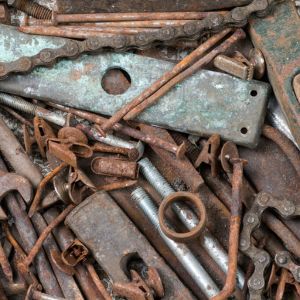 Rust’s first negative impact on a metal tool concerns its performance. As rust weakens the metal’s structure, potentially even deforming it, the tool will cease to work effectively. In the case of a blade, it will obviously become less sharp.
Rust’s first negative impact on a metal tool concerns its performance. As rust weakens the metal’s structure, potentially even deforming it, the tool will cease to work effectively. In the case of a blade, it will obviously become less sharp.
Although not as important as a decline in performance, rust also spoils a garden tool or machinery’s good looks. Let’s be honest, a shiny, highly polished saw blade or lawnmower chassis looks incredibly smart. Cover parts of either in reddish-brown oxide and disfigure them, and they suddenly become eyesores.
Finally, rust affects a tool’s durability. Once it appears, rust can spread very quickly, resulting in the tool completely failing to deliver, or even breaking. Unfortunately, this will mean that you need to spend time and money on finding a replacement.
Therefore, as rust can usually be avoided, it’s always best to make a little bit of effort to prevent it from appearing in the first place.
Keeping Tools Rust Free
In scientific terms, the way to protect your garden tools from rust is to prevent their iron or iron-alloy parts coming into contact with a combination of air and moisture.
In layman’s terms, it means doing the following…
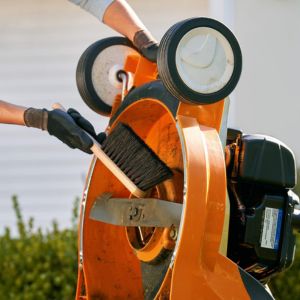 Clean and Dry After Use
Clean and Dry After Use
Whenever they’re used, garden tools will inevitably come into contact with some form of moisture, whether that be rain, dew, mud or sap. Therefore, even if they look superficially clean, it always makes sense to wipe or brush them down after use.
Once you’ve done this, be sure to dry them thoroughly with a cloth or towel before putting them into storage. Failure to do this is a sure-fire way to invite rust.
Suitable Storage
Once your metal garden products are clean and dry, it’s important to keep them that way. This is why it’s important to know how to prevent tools from rusting in shed.
 It goes without saying that you should store all of your metal tools undercover, especially over the winter months. If there’s insufficient room in your shed or garage, it’s definitely worth investing in a smaller, specialist tool storage unit. This will provide your tools with equal protection from the elements.
It goes without saying that you should store all of your metal tools undercover, especially over the winter months. If there’s insufficient room in your shed or garage, it’s definitely worth investing in a smaller, specialist tool storage unit. This will provide your tools with equal protection from the elements.
In terms of how to stop tools rusting in a shed or other storage unit, if the blade, file or similar tool came with a protective sheath or cover then use it. If not, wrap the tool in a cloth and store it in your tool box.
It’s also good practice to fully utilise hooks and shelves, as they keep your tools off the shed or garage floor, and so away from ground moisture.
For larger products with metal parts, for example ride-on mowers, a customised protective cover is a sound investment to protect the machine against rust.
These are the best ways how to stop tools going rusty in a shed.
Oiling Metal Tools
 A penetrating oil, like WD-40, is ideal for protecting your metal garden products from rust.
A penetrating oil, like WD-40, is ideal for protecting your metal garden products from rust.
However, it is not designed for lubrication, so it’s best to use a synthetic oil on the tool or machine’s moving parts. This will limit friction when you come to use the appliance.
Other Protective Coatings
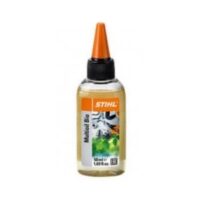 Although it might not be a practical way to protect most of your tools, applying paint, varnish or wax tape could also be used to protect certain other metal garden products from rust.
Although it might not be a practical way to protect most of your tools, applying paint, varnish or wax tape could also be used to protect certain other metal garden products from rust.
The reason is that all of these coatings isolate the iron (or its alloy) from the surrounding environment, so it cannot interact with air and moisture.
As a multi-purpose solution to preventing rust and corrosion, STIHL Multioil Bio and STIHL HS Care & Clean Kit Plus are both excellent choices, although please note that the former should not be used as a lubricant for chainsaws.
 Sharpening Metal Tools
Sharpening Metal Tools
Sharpening metal tools obviously keeps them cutting and sawing effectively, but it also helps protect them against rust because smooth, clean edges are far less likely to retain moisture than dull ones.
You can find out more about sharpening chainsaws here, hedge trimmer blades here, and lawnmower blades here.
Choosing the Right Metal Tools
 Aluminium does not rust. It is highly unlikely that stainless steel will, either. The former has a natural oxide layer of protection, while the latter is protected because it contains chromium and nickel. Galvanised steel has a certain degree of protection against rust too, but this is dependent on the integrity of its zinc coating.
Aluminium does not rust. It is highly unlikely that stainless steel will, either. The former has a natural oxide layer of protection, while the latter is protected because it contains chromium and nickel. Galvanised steel has a certain degree of protection against rust too, but this is dependent on the integrity of its zinc coating.
Knowing these things might not help you protect the tools you already own from rust, but they’re useful things to bear in mind when buying new ones.
Regular Inspections
Over the winter months, your tools could be sitting idle for a fair amount of time, so it’s a good idea to check they’re okay, at periodic intervals. Then, if you see rust emerging, you can nip it in the bud.
How Do You Get Rust Off Garden Tools?
Even the best-laid plans sometimes fail. Taking preventative action against rust can never guarantee that your metal tools and machinery will remain completely rust free.
So, if the worst happens, here are some effective ways of getting rust off garden tools.
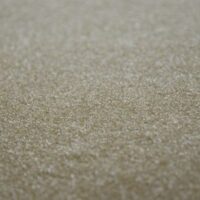 Sanding
Sanding
Wondering how to get rust off metal garden tools the easy way? Well, sandpaper is probably the most straightforward method of removing small amounts of rust from your tools and other metal equipment. And chances are you’ve already got some in your garage or shed, so there’s no need to incur additional expense.
Scouring Pads and Steel Wool
Both of these objects are simple alternatives to sandpaper. Again, you probably already own them.
Before using any of them, remove dirt and grease from the tools using soapy water, rinse, and dry thoroughly. Then, scrub the rust off the tool using the abrasive material.
 Power Tools
Power Tools
Should the rust be more stubborn, you may need to use a power tool, such as a sander, grinder, or drill with a wire wheel instead.
For example, when using a drill and wire wheel, firstly ensure that you’re working in a well-ventilated area. Coat the tool’s metal surface with WD-40, wait a few minutes, and then use the drill and wire wheel to remove the rust. You can finish the job off by removing any rust residue with fine-grain sandpaper.
 Natural Remedies
Natural Remedies
There are a range of traditional, old-fashioned remedies for removing rust, many of which you might already have in your kitchen cupboards. These include vinegar, baking soda and lemon, and potato and salt.
Vinegar is probably the most commonly used, with white and apple cider varieties being the most effective. To remove the rust, simply submerge the tool in the vinegar and leave it to soak for roughly half an hour. Then, remove the tool and use a brush to scrub away the rust. Finally, rinse and wipe the tool to remove any residue, and dry thoroughly.
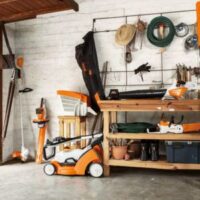 The Best Care for Garden Machinery
The Best Care for Garden Machinery
The best way to care for your garden tools and machinery is to shop with us. Not only do we sell Britain’s best range of garden machinery, our highly trained staff are always on hand to offer expert advice on how best to maintain it.
And if you’d like an overview of the protective covers, oils and other rust-preventing products that we stock, you’ll find them all within our Accessories category here.





